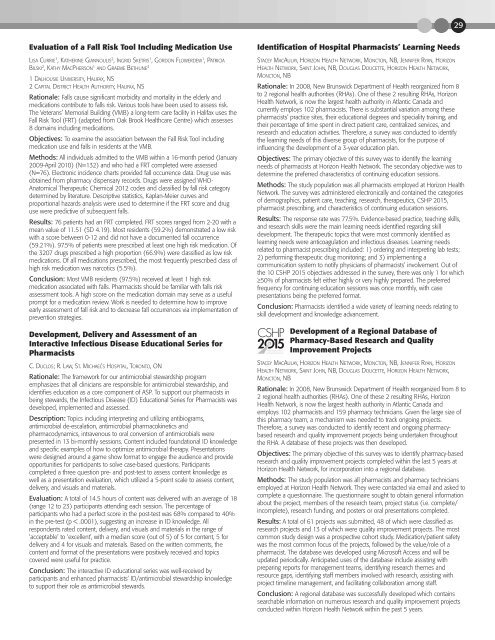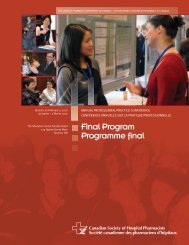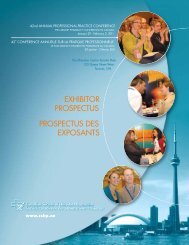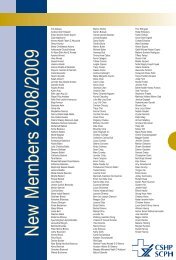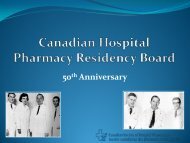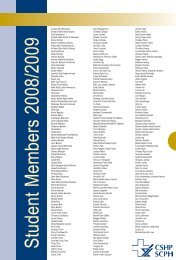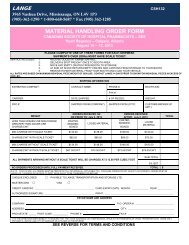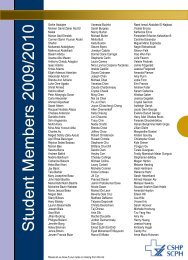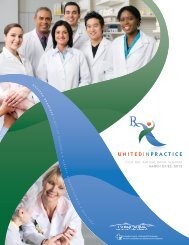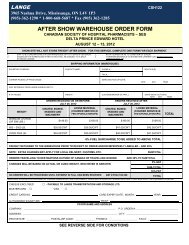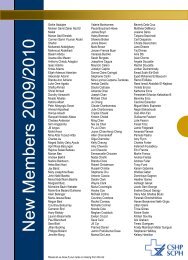Final Program - Canadian Society of Hospital Pharmacists
Final Program - Canadian Society of Hospital Pharmacists
Final Program - Canadian Society of Hospital Pharmacists
Create successful ePaper yourself
Turn your PDF publications into a flip-book with our unique Google optimized e-Paper software.
29<br />
Evaluation <strong>of</strong> a Fall Risk Tool Including Medication Use<br />
LISA CURRIE 1 , KATHERINE GIANNOULIS 2 , INGRID SKETRIS 1 , GORDON FLOWERDEW 1 , PATRICIA<br />
BILSKI 2 , KATHY MACPHERSON 1 AND GRAEME BETHUNE 2<br />
1 DALHOUSIE UNIVERSITY, HALIFAX, NS<br />
2 CAPITAL DISTRICT HEALTH AUTHORITY, HALIFAX, NS<br />
Rationale: Falls cause significant morbidity and mortality in the elderly and<br />
medications contribute to falls risk. Various tools have been used to assess risk.<br />
The Veterans’ Memorial Building (VMB) a long-term care facility in Halifax uses the<br />
Fall Risk Tool (FRT) (adapted from Oak Brook Healthcare Centre) which assesses<br />
8 domains including medications.<br />
Objectives: To examine the association between the Fall Risk Tool including<br />
medication use and falls in residents at the VMB.<br />
Methods: All individuals admitted to the VMB within a 16-month period (January<br />
2009-April 2010) (N=132) and who had a FRT completed were assessed<br />
(N=76). Electronic incidence charts provided fall occurrence data. Drug use was<br />
obtained from pharmacy dispensary records. Drugs were assigned WHO-<br />
Anatomical Therapeutic Chemical 2012 codes and classified by fall risk category<br />
determined by literature. Descriptive statistics, Kaplan-Meier curves and<br />
proportional hazards analysis were used to determine if the FRT score and drug<br />
use were predictive <strong>of</strong> subsequent falls.<br />
Results: 76 patients had an FRT completed. FRT scores ranged from 2-20 with a<br />
mean value <strong>of</strong> 11.51 (SD 4.19). Most residents (59.2%) demonstrated a low risk<br />
with a score between 0-12 and did not have a documented fall occurrence<br />
(59.21%). 97.5% <strong>of</strong> patients were prescribed at least one high risk medication. Of<br />
the 3207 drugs prescribed a high proportion (66.9%) were classified as low risk<br />
medications. Of all medications prescribed, the most frequently prescribed class <strong>of</strong><br />
high risk medication was narcotics (5.5%).<br />
Conclusion: Most VMB residents (97.5%) received at least 1 high risk<br />
medication associated with falls. <strong>Pharmacists</strong> should be familiar with falls risk<br />
assessment tools. A high score on the medication domain may serve as a useful<br />
prompt for a medication review. Work is needed to determine how to improve<br />
early assessment <strong>of</strong> fall risk and to decrease fall occurrences via implementation <strong>of</strong><br />
prevention strategies.<br />
Development, Delivery and Assessment <strong>of</strong> an<br />
Interactive Infectious Disease Educational Series for<br />
<strong>Pharmacists</strong><br />
C. DUCLOS; R. LAW, ST. MICHAEL’S HOSPITAL, TORONTO, ON<br />
Rationale: The framework for our antimicrobial stewardship program<br />
emphasizes that all clinicians are responsible for antimicrobial stewardship, and<br />
identifies education as a core component <strong>of</strong> ASP. To support our pharmacists in<br />
being stewards, the Infectious Disease (ID) Educational Series for <strong>Pharmacists</strong> was<br />
developed, implemented and assessed.<br />
Description: Topics including interpreting and utilizing antibiograms,<br />
antimicrobial de-escalation, antimicrobial pharmacokinetics and<br />
pharmacodynamics, intravenous to oral conversion <strong>of</strong> antimicrobials were<br />
presented in 13 bi-monthly sessions. Content included foundational ID knowledge<br />
and specific examples <strong>of</strong> how to optimize antimicrobial therapy. Presentations<br />
were designed around a game show format to engage the audience and provide<br />
opportunities for participants to solve case-based questions. Participants<br />
completed a three question pre- and post-test to assess content knowledge as<br />
well as a presentation evaluation, which utilized a 5-point scale to assess content,<br />
delivery, and visuals and materials.<br />
Evaluation: A total <strong>of</strong> 14.5 hours <strong>of</strong> content was delivered with an average <strong>of</strong> 18<br />
(range 12 to 23) participants attending each session. The percentage <strong>of</strong><br />
participants who had a perfect score in the post-test was 68% compared to 40%<br />
in the pre-test (p < .0001), suggesting an increase in ID knowledge. All<br />
respondents rated content, delivery, and visuals and materials in the range <strong>of</strong><br />
‘acceptable’ to ‘excellent’, with a median score (out <strong>of</strong> 5) <strong>of</strong> 5 for content, 5 for<br />
delivery and 4 for visuals and materials. Based on the written comments, the<br />
content and format <strong>of</strong> the presentations were positively received and topics<br />
covered were useful for practice.<br />
Conclusion: The interactive ID educational series was well-received by<br />
participants and enhanced pharmacists’ ID/antimicrobial stewardship knowledge<br />
to support their role as antimicrobial stewards.<br />
Identification <strong>of</strong> <strong>Hospital</strong> <strong>Pharmacists</strong>’ Learning Needs<br />
STACEY MACAULAY, HORIZON HEALTH NETWORK, MONCTON, NB, JENNIFER RYAN, HORIZON<br />
HEALTH NETWORK, SAINT JOHN, NB, DOUGLAS DOUCETTE, HORIZON HEALTH NETWORK,<br />
MONCTON, NB<br />
Rationale: In 2008, New Brunswick Department <strong>of</strong> Health reorganized from 8<br />
to 2 regional health authorities (RHAs). One <strong>of</strong> these 2 resulting RHAs, Horizon<br />
Health Network, is now the largest health authority in Atlantic Canada and<br />
currently employs 102 pharmacists. There is substantial variation among these<br />
pharmacists’ practice sites, their educational degrees and speciality training, and<br />
their percentage <strong>of</strong> time spent in direct patient care, centralized services, and<br />
research and education activities. Therefore, a survey was conducted to identify<br />
the learning needs <strong>of</strong> this diverse group <strong>of</strong> pharmacists, for the purpose <strong>of</strong><br />
influencing the development <strong>of</strong> a 3-year education plan.<br />
Objectives: The primary objective <strong>of</strong> this survey was to identify the learning<br />
needs <strong>of</strong> pharmacists at Horizon Health Network. The secondary objective was to<br />
determine the preferred characteristics <strong>of</strong> continuing education sessions.<br />
Methods: The study population was all pharmacists employed at Horizon Health<br />
Network. The survey was administered electronically and contained the categories<br />
<strong>of</strong> demographics, patient care, teaching, research, therapeutics, CSHP 2015,<br />
pharmacist prescribing, and characteristics <strong>of</strong> continuing education sessions.<br />
Results: The response rate was 77.5%. Evidence-based practice, teaching skills,<br />
and research skills were the main learning needs identified regarding skill<br />
development. The therapeutic topics that were most commonly identified as<br />
learning needs were anticoagulation and infectious diseases. Learning needs<br />
related to pharmacist prescribing included: 1) ordering and interpreting lab tests;<br />
2) performing therapeutic drug monitoring; and 3) implementing a<br />
communication system to notify physicians <strong>of</strong> pharmacists’ involvement. Out <strong>of</strong><br />
the 10 CSHP 2015 objectives addressed in the survey, there was only 1 for which<br />
≥50% <strong>of</strong> pharmacists felt either highly or very highly prepared. The preferred<br />
frequency for continuing education sessions was once monthly, with case<br />
presentations being the preferred format.<br />
Conclusion: <strong>Pharmacists</strong> identified a wide variety <strong>of</strong> learning needs relating to<br />
skill development and knowledge advancement.<br />
2 CSHP<br />
Targeting Excellence<br />
in Pharmacy Practice<br />
Development <strong>of</strong> a Regional Database <strong>of</strong><br />
Pharmacy-Based Research and Quality<br />
Improvement Projects<br />
STACEY MACAULAY, HORIZON HEALTH NETWORK, MONCTON, NB, JENNIFER RYAN, HORIZON<br />
HEALTH NETWORK, SAINT JOHN, NB, DOUGLAS DOUCETTE, HORIZON HEALTH NETWORK,<br />
MONCTON, NB<br />
Rationale: In 2008, New Brunswick Department <strong>of</strong> Health reorganized from 8 to<br />
2 regional health authorities (RHAs). One <strong>of</strong> these 2 resulting RHAs, Horizon<br />
Health Network, is now the largest health authority in Atlantic Canada and<br />
employs 102 pharmacists and 159 pharmacy technicians. Given the large size <strong>of</strong><br />
this pharmacy team, a mechanism was needed to track ongoing projects.<br />
Therefore, a survey was conducted to identify recent and ongoing pharmacybased<br />
research and quality improvement projects being undertaken throughout<br />
the RHA. A database <strong>of</strong> these projects was then developed.<br />
Objectives: The primary objective <strong>of</strong> this survey was to identify pharmacy-based<br />
research and quality improvement projects completed within the last 5 years at<br />
Horizon Health Network, for incorporation into a regional database.<br />
Methods: The study population was all pharmacists and pharmacy technicians<br />
employed at Horizon Health Network. They were contacted via email and asked to<br />
complete a questionnaire. The questionnaire sought to obtain general information<br />
about the project, members <strong>of</strong> the research team, project status (i.e. complete/<br />
incomplete), research funding, and posters or oral presentations completed.<br />
Results: A total <strong>of</strong> 61 projects was submitted, 48 <strong>of</strong> which were classified as<br />
research projects and 13 <strong>of</strong> which were quality improvement projects. The most<br />
common study design was a prospective cohort study. Medication/patient safety<br />
was the most common focus <strong>of</strong> the projects, followed by the value/role <strong>of</strong> a<br />
pharmacist. The database was developed using Micros<strong>of</strong>t Access and will be<br />
updated periodically. Anticipated uses <strong>of</strong> the database include assisting with<br />
preparing reports for management teams, identifying research themes and<br />
resource gaps, identifying staff members involved with research, assisting with<br />
project timeline management, and facilitating collaboration among staff.<br />
Conclusion: A regional database was successfully developed which contains<br />
searchable information on numerous research and quality improvement projects<br />
conducted within Horizon Health Network within the past 5 years.


